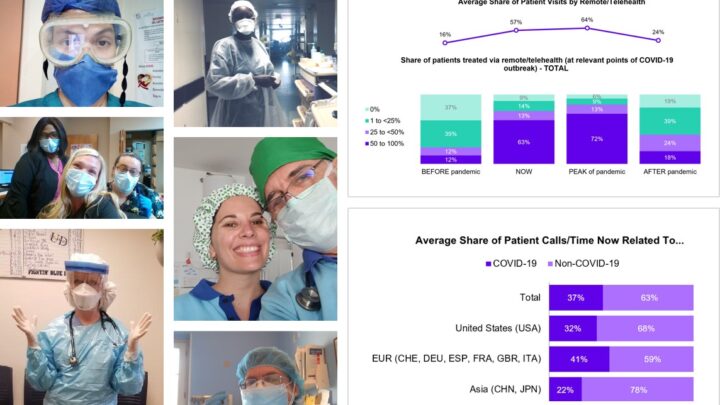
Telehealth usage skyrocketed by 766% in the initial three months of COVID-19 pandemic1, transforming it from a specialty tool to a critical care component. But how will telehealth look in 2025 and beyond?
Telemedicine (interaction via video appointments), telehealth (remote tracking of clinical biomarkers) and telecare (remote supervision through devices, alerts and sensors)2 are all fundamental elements of today’s healthcare. However, the future is likely to embrace a hybrid model, mixing telehealth with in-person care.
This integrated approach to care has been shown to heighten patient satisfaction, with 82% of patients preferring it3, and supports better chronic disease management through continuous follow-ups and education.
Currently, 83% of healthcare providers endorse its use, a leap from 73% before the pandemic4. Yet surprisingly, 13% of Sermo community physicians do not use it. So, what explains this gap?
This article delves into real-life experiences, challenges, and the trends molding the future of telehealth and provides insights into the best implementation practices.
What percentage of doctors integrate telehealth, and why?

According to a recent Sermo poll, 78% of Sermo physicians work in clinics or practices that offer telehealth services, while 13% work where it’s not accepted. For smaller establishments, this could be due to practical reasons, like traditional communication methods meeting their needs:
“In my small solo private practice, I have striven to remain easily accessible during office hours and beyond via smart phone (texting) and email. I have so far not found it necessary to introduce Telehealth5.”
However, the reasons for not hopping on the telehealth train vary and aren’t limited to the size of the practice. Some doctors face workload pressure, technological hurdles and regulatory worries or simply prefer in-person care.
Understanding the context of telemedicine usage will help comprehend why some physicians flourish within it while others remain wary.
To successfully implement telehealth, HCPs must assess their specific needs and address potential barriers such as workload, technology, and regulatory concerns, ensuring that telemedicine complements their existing care methods rather than complicates them.
What can doctors’ telehealth experiences reveal about its practical implementation?
Telehealth benefits

Telemedicine offers a range of advantages that are reshaping healthcare delivery. From increased access in rural areas to more efficient patient care, telehealth is providing significant benefits for both patients and healthcare systems.
Virtual care is improving convenience, boosting care quality, and offering cost-saving opportunities for practices and hospitals alike, which is why some physicians are welcoming telemedicine into their practice.
Increased access and convenience
Telehealth’s most significant appeal is its potential to boost access to care, especially in rural and underserved regions5. Virtual appointments dismiss the need for commute, allowing patients to receive care from home. For frail or homebound patients, this is a drastic shift:
“Telehealth has proven beneficial for frail individuals or those unable to leave the house5.”
Fundamentally, telemedicine can be used to enable faster access to specialists who might not be locally present, reducing wait times and enhancing overall patient satisfaction.
Promotes uninterrupted care
Telemedicine doesn’t just broaden access; it also boosts the continuity of care.
Virtual appointments mean more regular follow-ups, particularly in managing chronic illnesses like diabetes6.This constant tracking can prevent complications and decrease hospital revisit rates.
As a result, establishing virtual meetings can empower a physician to provide concentrated, timely care, identify changes in health conditions sooner7, and react promptly without the need for constant in-person appointments.
Cost-effective and alleviates healthcare strains
Telemedicine further presents cost benefits for healthcare systems. A study of Telehealth users shows 88.6 fewer ER visits per 1000 individuals per year compared with non-users8.
With fewer in-person visits, telemedicine could reduce the pressure on emergency rooms and general practices, making healthcare more efficient. This efficiency can assist healthcare systems in better resource allocation while decreasing operational costs8.
Telehealth not only expands access to care, particularly for underserved populations, but also improves continuity of care, reduces ER visits, and enhances overall efficiency, making it a valuable tool for both your patients’ satisfaction and cost-effective healthcare delivery.
Telemedicine challenges
Despite the widespread acceptance of telehealth, not all physicians are entirely pleased with its execution. While 68% of respondents are content with telehealth’s implementation in their practice, a quarter still prefer seeing more patients face-to-face5. So, what sparks the worries and why are many physicians opposed to adopting telemedicine in their practice?
Misuse concerns
Several physicians continue to worry about telehealth misuse, specifically concerning patient or provider overdependence on virtual meetings:
“Both parties can easily misuse it, sadly. So I only offer in special circumstances5.”
Some physicians, such as the Sermo community member quoted above, only offer telehealth in special circumstances, as overuse could undermine thorough care. The balance between convenience and clinical necessity remains critical in safeguarding telehealth’s benefits while mitigating risks.
While telemedicine provides numerous perks, physicians must still navigate its boundaries, especially in balancing virtual care with traditional, hands-on treatment.
Preference for face-to-face consultations

Many doctors still favor in-person meetings, particularly when a physical exam is critical for accurate diagnosis:
“I lean towards face-to-face meetings, as nothing can substitute close examination and palpation5.”
Therefore, physicians should reserve resources to tackle the difficulty of conducting thorough exams virtually, which can lead to diagnostic limitations and necessitate scheduling in-person follow-ups.
Finding the balance between telemedicine and in-person care
Ideally, telemedicine should give physicians more control over their time by limiting in-person visits. However, in reality, doctors mention that fluctuating between virtual and in-person appointments throughout the day can be disruptive:
“Telehealth appointments need to be bunched together; it is too tough to switch back and forth5.”
This constant switching, paired with the added complexity of telehealth oversight, can contribute to physician burnout. A McKinsey survey found workload intensity as a significant factor in 66% of US physicians’ intention to exit the field within the next five years9. So, any doctor implementing telehealth should account for admin and learning time for its practice.
Technical hurdles and inequalities
Another hurdle telemedicine faces is the digital divide, and telemedicine’s future will largely depend on more advanced technology availability. Even though adoption is high, 38% of doctors highlight the need for better patient access to telehealth technologies, and 22% request upgraded tools for providers5.
Moreover, not all patients possess the technology or digital literacy required for virtual care, which can intensify healthcare inequalities.
“To answer intelligently, one must define ‘telehealth’. If you refer to cell phones, text messaging, and FaceTiming, I foresee its expansion. If you mean purchasing specialized platforms solely to conduct a ‘secure’ remote discussion (no exam), I see it stagnating – no expansion there5.”
This makes it critical to enhance access to technology and address fair use inequalities to ensure all patients can reap the benefits of this care mode.
While the benefits of telehealth have been highlighted, physicians must carefully manage its use to avoid overdependence, ensure accurate diagnosis, and reduce disruption to workflows. Addressing concerns like workload balance, technical access, and patient equity is crucial for maximizing the effectiveness of telehealth in healthcare.
What are the telemedicine regulations and practical considerations?

As telemedicine expands, doctors encounter evolving regulatory hurdles, particularly in billing and reimbursement. Achieving parity between virtual and in-person visit payments5 is a struggle for many, underscoring the need for updated policies.
Legal and ethical issues also surface, especially around patient privacy and HIPAA compliance. Sermo members have expressed anxiety about possible malpractice, spotlighting the need for clear guidelines5.
Navigating these complexities adds to the challenge of successfully integrating telehealth, making it vital for doctors to stay informed as the landscape keeps evolving.
What telehealth trends should doctors anticipate moving forward?
Looking forward, 90% of respondents predict the continued growth of telehealth use5, fueled by emerging technologies such as:
- Artificial Intelligence (AI) for diagnosis
- Augmented and Virtual Reality for immersive consultations
- Robotics for remote surgeries and tracking
- The Internet of Things (IoT) and wearables for real-time health monitoring
- Cloud computing for patient data integration
Patients demanding convenience are also propelling telehealth forward, with 55% of patients reporting greater satisfaction with virtual visits10. Even older adults (54.5%) are welcoming telehealth11. Fields like primary care (70% adoption12) and psychiatry (50%13) are adjusting rapidly.
As telehealth continues to evolve, physicians should prepare for increased integration of advanced technologies such as AI, virtual reality, and IoT, which will play a role in improving diagnostic capabilities and patient monitoring. The growing demand for convenience, especially among patients, will further drive telehealth’s adoption across various specialties.
The verdict

Telehealth isn’t going anywhere. With 90% of physicians expecting its continued growth5 and many already witnessing its positive ripple effects.
“The surge has been received positively, leading to new ideas and inventions in this area. It’s a significant advancement for this field.” – Sermo Member.
While it enhances access and productivity, challenges remain around technology, regulations, and balancing virtual with in-person care.
A hybrid model offers the best of both worlds, giving doctors the opportunity to increase patient satisfaction while improving chronic disease management. This could be the approach to consider moving forward.
Want more insights? Connect with the Sermo community
You don’t have to navigate the hurdles and opportunities of telemedicine alone. The Sermo community offers a wealth of knowledge and support from colleagues actively involved in virtual care. Join the Sermo community to:
- Share your telemedicine experiences and learn from others.
- Participate in forthcoming polls on telemedicine trends and challenges.
- Network with colleagues to exchange strategies and solutions for incorporating telehealth into your practice.
Footnotes
- AJMC
- Williams OE, Elghenzai S, Subbe C, Wyatt JC, Williams J. The use of telemedicine to enhance secondary care: some lessons from the front line. Future Healthc J. 2017 Jun;4(2):109-114. doi: 10.7861/futurehosp.4-2-109. PMID: 31098445; PMCID: PMC6502630.
- ViClinic
- Bukstein DA, Eghrari-Sabet J, Hart M, Hill T, Parikh P, Winders TA. COVID-19 pandemic impact on telehealth use and perceptions for atopic and respiratory disease: Survey results. Allergy Asthma Proc. 2022 May 1;43(3):194-201. doi: 10.2500/aap.2022.43.220019. PMID: 35524354; PMCID: PMC9106096.
- Sermo
- The Access Group
- Newham London
- Health Affairs Scholar
- Fierce Healthcare
- McKinsey & Company
- UCLA
- Callaghan T, McCord C, Washburn D, Goidel K, Schmit C, Nuzhath T, Spiegelman A, Scobee J. The Changing Nature of Telehealth Use by Primary Care Physicians in the United States. J Prim Care Community Health. 2022 Jan-Dec;13:21501319221110418. doi: 10.1177/21501319221110418. PMID: 35795898; PMCID: PMC9274427.
- McKinsey & Company















